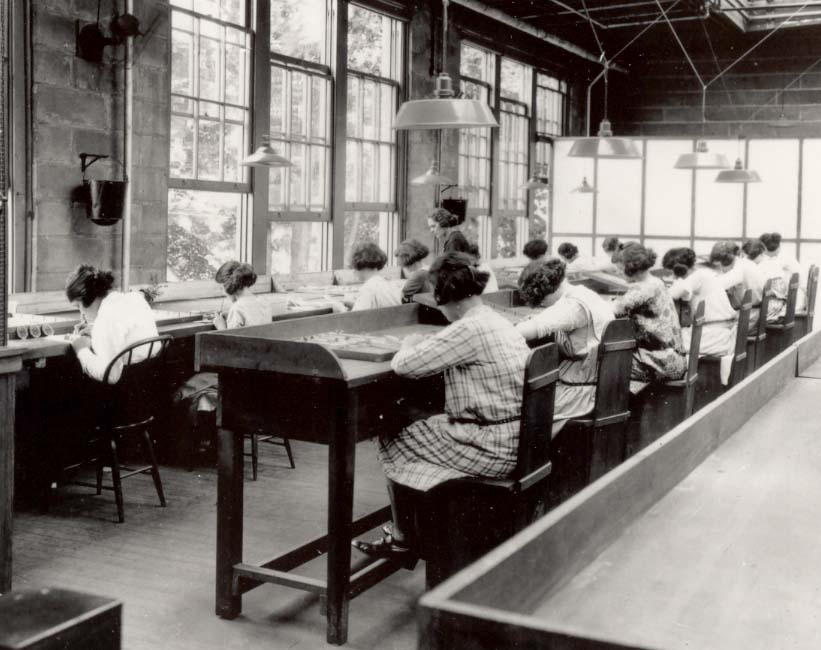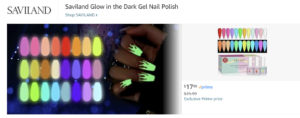In 1902 Marie and Pierre Curie discovered Radium in the form of Radium Chloride from ore they mined in 1898 from a small town in the Czech Republic. At this time Radium was believed to have many beneficial qualities and began to be used in various products.
Radium had successfully treated cancer, so it was considered to have some healing powers. Many believed because it glowed, it must be a magical cure. However, there was just not enough information about radium yet.
Soon, you could buy various food products with radium in it. Radium-infused products included toothpaste, hair cream, hemorrhoid cream, hot chocolate, butter, and a type of energy drink called Radithor which was Radium mixed with distilled water. Doctors believed it eased the pain of sports injuries.
Radium spas began opening, you could bathe in Radium, and even add it to your champagne.
By World War 1, Radium was infused into the paint, which allowed the paint to glow.
The problem was… Radium is also known as the alkaline earth metal and is radioactive. We now know that exposure to radioactive material is dangerous and can lead to cancer, tissue damage, and failure of organs.
Though during WWI, the need for glowing dials and other items was significant. The United States Radium Corporation, founded in 1914 began higher production of glow-in-the-dark watches and gauges in 1917.
Most U.S. Radium Corp. workers were women. This was typical during wars as most men all went to war. The corporation began producing the radioluminescent paint as well as the application of the paint.
The company began to market their luminescent paint by the name of, Undark.
Undark was a combination of radium and zinc sulfide, the radiation in the radium caused the sulfide to fluoresce.
The need for watches, aircraft gauges, and other dials increased and the task of painting of these dials and gauges was mostly done by young women. The young women would use fine-tip paintbrushes to paint watches and dials. To keep the tip of the brush fine and pointed, the young women would place them in their mouths, pressed between their lips to keep the tip pointed.
Since radium was believed to have health benefits, most employees considered this a perk of the job. Other workers did question the safety of the lip dip method of painting but were assured that it was completely safe.
At some point, a few of the women tried to stop the lip dip method for safety reasons, but the company indicated it would be too costly to try another method. In the 1920s, one gram of radium cost $100,000.
In time there were multiple facilities throughout the country, though the Orange, New Jersey location, was responsible for painting the dials and other items. Women were often excited to work in this facility. The conditions were pleasant, the pay was good and the work was secure. Women also believed it was a safe environment compared to working in an ammunition factory.
Some women would use radium to paint their nails or rub on their teeth to give them a glow. The women that painted the items with the luminescent paint, came to be known as the Ghost Girls. The radium dust they were exposed to daily began to make their hair, skin, and even their clothes, glow.
Sometimes the women would wear their best dress to work during the day, so by the evening when they went dancing…It would glow. Some would wear it on their lips and put it in their hair, so they would shine.
It wasn’t long before the women, began to experience physical issues from the daily exposure.
Mollie Maggia experienced a toothache and a tooth had to be removed when visiting the dentist, not long after, a tooth next to the first also had to be removed. Maggie then developed ulcers, pus and bleeding in the areas that her teeth had been extracted. These issues moved throughout Mollie’s mouth and lower jaw and then into other parts of her body.
Mollie was the first dial painter to die. She passed on September 12th, 1922 from a hemorrhage. Doctors could not identify what caused Mollie’s death, so they determined it was syphilis. She died a horrible and painful death suffering over a 2 year period and with those around her believing she had syphilis at 24 years old.
Not long after Mollies death, many other women from the same painting department began having the same horrific symptoms. The employer, U.S. Radium Corporation denied any connection between their factory and the women’s symptoms or deaths.
Many of the women suffered severely before their deaths and others just had irreversible damage.
The business began to slow as the news of the Radium girls spread. The controversy and loss of business caused the company to hire someone to conduct an independent study to determine if these women were dying from radium exposure. At the end of the study, they did not release the results and hired others to perform more studies indicating that the women’s deaths had no connection to them.
This led the general public to continue believing radium was safe.
By 1925, Harrison Martland, an American Pathologist developed a test to determine whether radium was dangerous to the painters using it daily. Martland determined that small traces of radioactivity was present in the luminous paint that was used by the women.
Obviously, the radium industry pushed back. Resisting these findings, but the Radium Girls fought for the truth to be exposed. At this time many of the women knew they were dying, but wanted to fight for justice for their colleagues and friends.
With multiple dial painting companies now open, there were overwhelming amounts of women exposed to radium.
It wasn’t until 1927 that the radium girls were able to secure legal counsel. Attorney Raymond Berry took the case. Some women were so gravely ill they were forced to take out-of-court settlements. Their fight was hindered by their rapidly failing health as well as the U.S. Radium Corporation denying any involvement in the women’s health issues or deaths and a statute of limitations…
The Radium Girls fought back as hard as they could and many won settlements, though, they never lived long enough to collect them. There were factories outside of New Jersey and many sickly women from those factories also began to sue the company. It is alleged that the corporation purposely delayed court hearings, causing more to die.
In 1938, a dying radium worker sued the Radium Dial Company due to her illness. Catherine Wolfe Donohue testified about her times in the Radium painting factory during her court hearings. She was 70lbs, her teeth and jaw were disintegrating, she had a tumor on her hip, and could no longer walk.
During the hearings, Catherine collapsed and had to be carried into the room to testify. After a doctor testified to Catherine’s condition was she allowed to testify from home. From her sofa in her home, she demonstrated how the brush was pulled to a fine tip with her lips, causing her and others to be directly exposed to the radium many times throughout their work days.
Catherine won her case. Based on her case, new laws began to form for worker compensation as well as employee safety laws and ultimately led to the U.S. Occupational Safety and Health Administration. Catherine passed before she was able to see her settlement.
Her widowed husband Tom ended up bankrupt after caring for his ailing wife and only saw $5,700. This was not even close to the amount spent on Catherine’s medical bills.
Meanwhile, Radium Dial continued to file appeals well after her death, but the Supreme Court refused to hear them in court.
Radium dials were continuously produced through the 20th century and eventually replaced in the 1970s with a non-toxic and non-radioactive material. This was used through the 1990s. Now we use something called Super-LumiNova, it is a strontium-aluminate, which is non-radioactive and a non-toxic photoluminescent material. And we are told… It is completely safe…



